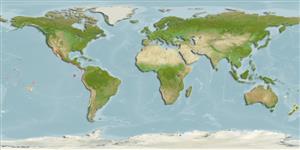ກຸ່ມປາກະດູກອ່ອນ (ເຊັ່ນ: ປາສະຫລາມ, ປາຜາໄລ) (sharks and rays) >
Myliobatiformes (Stingrays) >
Urotrygonidae (American round stingrays)
Etymology: Urotrygon: Greek, oura = tail + Greek, trygon = a sting ray (Ref. 45335).
More on author: Günther.
Environment: milieu / climate zone / depth range / distribution range
ນິເວດວິທະຍາ
ສັດທະເລ ອາໄສຢູ່ໃກ້ໜ້າດິນໃຕ້ພື້ນທ້ອງນ້ຳ; ລະດັບຄວາມເລິກ 1 - 60 m (Ref. 58018). Subtropical; 32°N -
Eastern Pacific: Gulf of California to Peru and Chile.
ຂະໜາດ / ນ້ຳໜັກ / Age
Maturity: Lm ? range ? - ? cm
Max length : 41.9 cm TL ຕົວຜູ້/ບໍ່ມີເພດ; (Ref. 9265); common length : 35.0 cm TL ຕົວຜູ້/ບໍ່ມີເພດ; (Ref. 9265)
Found on soft bottoms of shallow water (Ref. 9265). Feeds mainly on small crustaceans, mollusks, polychaete worms and fishes (Ref. 37955).
Life cycle and mating behavior
ການຈະເລີນເຕັມໄວ | ການສືບພັນ | ການວາງໄຂ່ | ໄຂ່ | ຄວາມດົກຂອງໄຂ່ປາ | ຕົວອ່ອນ
Ovoviviparous.
McEachran, J.D., 1995. Urolophidae. Rayas redondas. p. 786-792. In W. Fischer, F. Krupp, W. Schneider, C. Sommer, K.E. Carpenter and V. Niem (eds.) Guia FAO para Identification de Especies para lo Fines de la Pesca. Pacifico Centro-Oriental. 3 Vols. FAO, Rome. (Ref. 9265)
IUCN Red List Status (Ref. 130435: Version 2024-2)
Human uses
ເຄື່ອງມື
Special reports
Download XML
ແຫຼ່ງອີນເຕີເນັດ
Estimates based on models
Preferred temperature (Ref.
123201): 19.4 - 28.6, mean 24.7 °C (based on 86 cells).
Phylogenetic diversity index (Ref.
82804): PD
50 = 0.5001 [Uniqueness, from 0.5 = low to 2.0 = high].
Bayesian length-weight: a=0.01660 (0.00788 - 0.03495), b=3.10 (2.91 - 3.29), in cm total length, based on LWR estimates for this species & (Sub)family-body (Ref.
93245).
ຊັ້ນເຂດຮ້ອນ (Ref.
69278): 3.6 ±0.53 se; based on food items.
ຄວາມຢືດຢຸ່ນ (Ref.
120179): ຕຳ່, ປະຊາກອນຕຳ່ສຸດທີ່ໃຊ້ເວລາສອງເທົ່າ 4.5 - 14 ປີ (Assuming fecundity<100).
Fishing Vulnerability (Ref.
59153): Low to moderate vulnerability (32 of 100).
